In November 2004 we set out on a journey to Navarra and La Rioja
Friday 5th November
We left at 10.00 a.m. and travelled on the A7, past Valencia and left at Exit 46 beyond Castellon and joined the N340.
After a Petrol station on the right, you will come to a left turning to Desierto de las Palmas. From here it is straight on past a little chapel on a hill and quickly up into the mountains.

Desierto de las Palmas
This nature reserve was, until recently a favourite beauty spot. Hopefully, it will be again after a forest fire in 1985 and one in 1992. You get great views of the coast.
The highest point is Mount San Miguel reaching 729 metres. Beneath the summit at 459 m is the Monasterio del Desierto de las Palmas which was built in 1796. The museum and church are open to visitors

From here you start to descend and turn right for Bar Restaurant Desierto de las Palmas which belongs to the monastery and has a glass-enclosed dining room giving more panoramic views. Below the restaurant in the valley, you will see the pink ruins of the former 17th-century monastery which was inadvertently built on a fault line and fell down twice before the monks moved to more secure ground up the hill.
Turn left at the bottom of the hill and pass under the main road to reach Benicassim a resort dating back from long before the days of mass tourism and which is still popular for its benign micro-climate Stop here to sample liqueur courtesy of the Carmelite Monks of the Desierto de las Palmas at the Bodega Carmelitanas.
Saved the best part of the day for Peniscola, a town which is as picturesque as it is historic. It still has some charm though now a tourist resort.

To get there carry straight on up the N340 north from Benicassim (after about 10 km there is a motorway entry if you prefer to speed up your journey and turn off for Peniscola).
The old quarter of white houses, surrounded by walls and fortifications, clusters around a promontory jutting into the sea. In the middle of it stands the castle which was once home to the controversial 15th-century papal pretender Pope Benedict X111 – better known in Spain as Papa Luna. The castle, built by the Knights Templar, has been skilfully restored. You have a view of the Costa del Azahar. The wide beach to the north was used to film El Cid, starring Charlton Heston (the castle being in the background) We ate lunch in a small tapas family restaurant on the steeply sloping streets. We then travelled on through Benicarlo and on to Vinaros. This area was a flat holiday area with camping and fairly unattractive.
At Vinaros we took the N232 to Morella – signposted to Zaragoza
Morella (pop 3,100) is built around a massive rock rising to 1,000 metres out of the magnificent mountain landscape. It retains its old city walls intact and the streets which have barely changed over the last four centuries. We visited the church and walked the old streets – This is a truly lovely old town. Bought some products from the area for presents.

Morella
The Maestrazgo, which straddles the mountainous border between the provinces of Castellon and Teruel has yet to be discovered by the majority of tourists who come to Eastern Spain. Away from Morella, you will be one of the few outsiders to venture to the nearby towns and mountains. There are good lanes for cycling and endless countryside for hill walking. Almost everywhere you go you will be met with interest and kindness from a people used to fending for themselves in a remote region and not yet corrupted by indiscriminate tourism. Just one view of the Maestrazgo

Leave Morella on the CS840 for Forcall a road which follows a line of crags.
This trip we did not do as running out of time – perhaps another time? – Pass the Forcall turning on the left for now and follow the road along the Bergantes valley past Ortells and Zorita del Maestrazgo – two ancient towns with fine, but crumbling buildings gathered around defiant Church towers.
Keep going up the valley and at last, you will see the spectacular shrine of La Balma, which looks like half a church and a house stuck precariously to a vertical wall of rock.
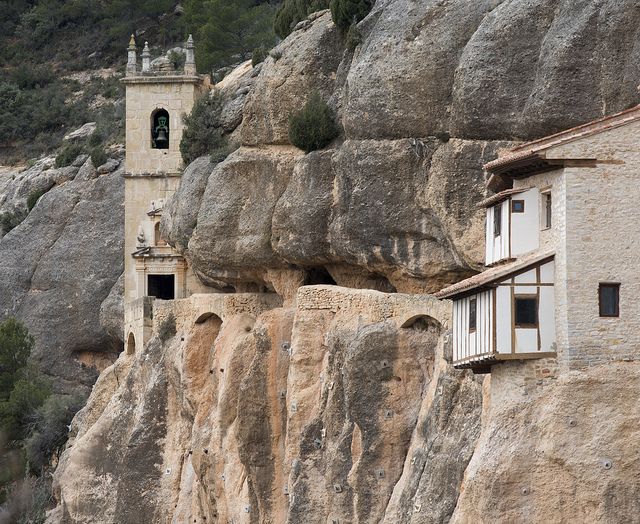
This has been a place of pilgrimage since a shepherd discovered the image of a black virgin here in the 14th Century
The shrine is in a cave halfway up the cliff: its ceiling is a sloping bulk of the black rock. Access is by a ledge – you have to duck in places. An anteroom contains a bizarre collection of exvotos – plastic effigies of arms, legs stomachs and so on – given to the Virgin by devotees in gratitude for her miraculous cures. Next to the shrine is a guest house and bar in which you can eat paella made with mountain snails Return down the valley to Forcall (pop 740)
Forcall has a porticoed square with two 16th century palaces, one of which is a hotel the other has a restaurant in its basements. Closed 15 days in November? Here you can eat Forcall soup, rabbit cooked with snails and curds underneath ogival and semicircular arches.

Forcall
Then take the road to La Mata de Morella which runs along a wide, green agricultural valley. When we visited the road was under repair and was terrible!
When you see the walls of Mirambel turn left just before where there is a cross – Keep on the left of the cross down the side of the walls and enter under the arch.
If you had approached Mirambel (pop 170) 500 years ago it probably wouldn’t have looked much different. Few places in Spain have been both preserved and restored as well as this walled medieval village, which was presented with a prize in 1981 by Queen Sofia for its outstanding beauty. The cylindrical Torre de la Sacristia, with its tiny, pointed roof, stands proud of the walls beside the main gateway of the Portal de las Monjas.
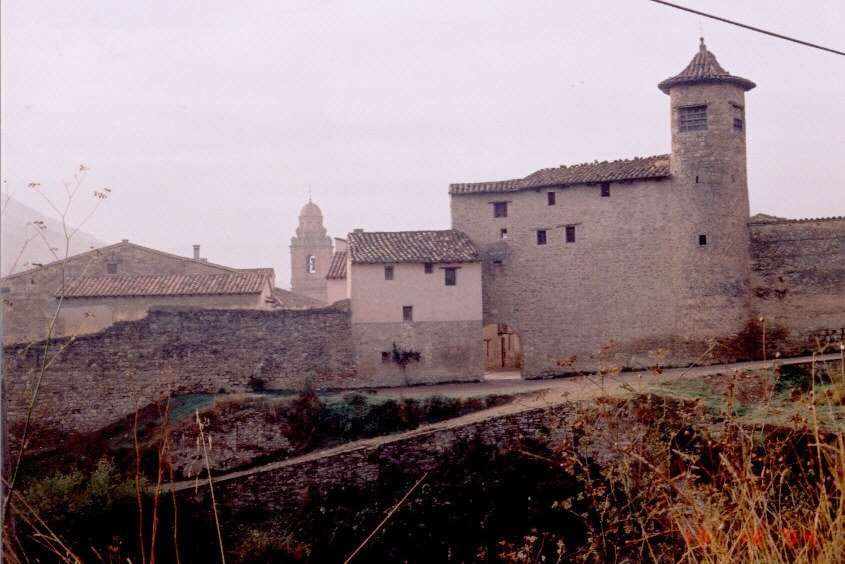
Mirambel
The cobbled streets are lined with tall Gothic mansions, their stonework meticulously cleaned and re-pointed. Each has a large wooden door, contained by an arched portal, small iron grilles over the windows, overhanging balconies enclosed in Celosias, and a line of small windows under the overhanging eaves to aerate lofts once used for storing food. Behind the façade of Fonda Guimera is a modernised bar-restaurant-hotel. This is a simple inexpensive place to stay or eat.
A place so well preserved that when Ken Loach came to film Land & Freedom it sufficed to move a few cars and the cameras were up and rolling for his 1930s drama
A pleasant video of Mirambel
We stayed at Hostal Fonda Guimera which was €28 euros including breakfast


View from Hotel

Main Street in Mirambel
Walked the village and visited the only other bar!
Saturday 6th November
The first day’s mileage was 383 km
Leaving just before 10.00 a.m.we went back to Olocau del Rey (pop 180) on the CV121 – which is a reddish-coloured town. Was old and crumbling, but has now been restored as many of these poor small towns in the Maestrazgo it has some mansions with overhanging eaves of carved wood and once-proud doorways.

The countryside around Olocau del Rey
There is a bar restaurant in the basement of one of these mansions, which was formerly the home of the Marquises of Figueras. A fig leaf, from which the family name derives, is carved over the main doorway. The church (ask for the key in the restaurant) treasures a 13th-century Romanesque carving of the Virgin & Child. It also has a secret chapel: a small alcove with a vaulted ceiling of bare stone. It’s hidden by a side altar and can only be visited with permission from the bar owner who will fetch a torch and take you crawling through a hole.
This area is beautiful with rolling hillsides – rosemary fields – much agriculture and few homes in a fertile valley
Castellote is a town at the top of a hill with a long tunnel going through to the other side – still a farming area with cows and sheep and then onto Mas de los Matas, Calanda and then Alcaniz – see map and places of interest in Morella file.
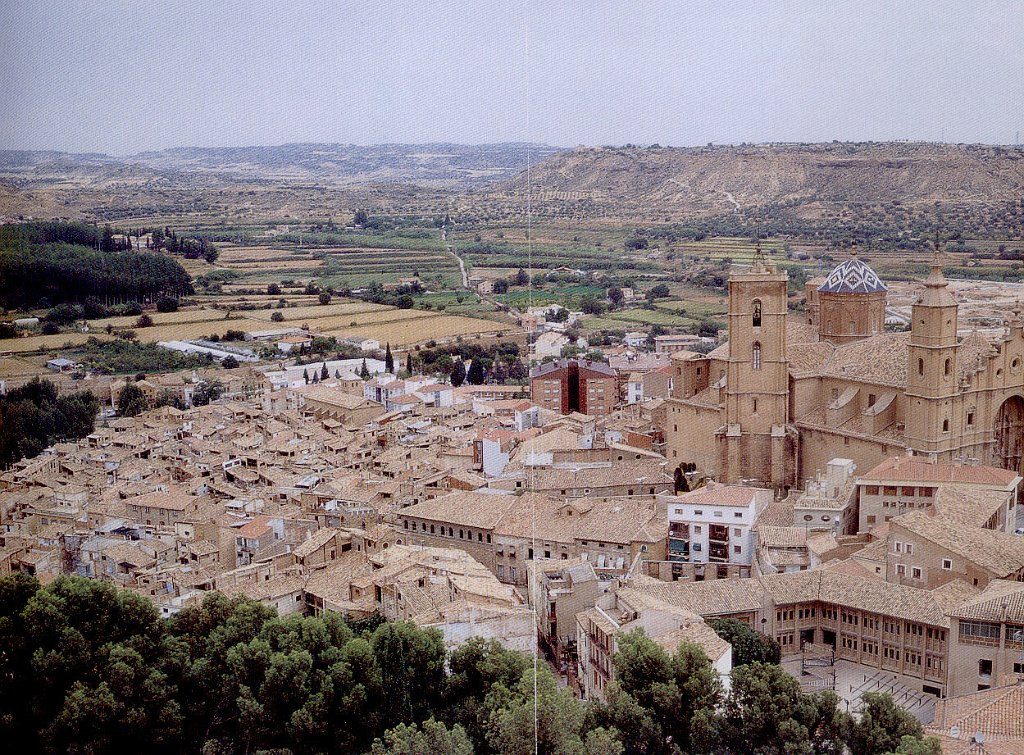
Alcaniz
We visited the town and then took the quick route to Tudela,
Parked in the Mercadona Car Park in Tudela which is a good central spot to visit the town (see city map in the file). It was founded by the Moors, the second city of Navarra. Don’t be disheartened by its protective coating of dusty, gritty sprawl but head straight for its picturesque, labyrinthine Moorish-Jewish kernel, around the elegant 17th century Plaza de los Fueros – see the Gothic Cathedral and the palace of Casa del Almirante. A video

Tudela
Took NA134 to the Bardenas Reales which is a striking desert region straight out of the American Far West. Erosion has sculpted steep tabletops, weird wrinkled hills and rocks balanced on pyramids. The best way to see it is by the GR13 walking patch crossing its northern extent from the Hermitage of the Virgen del Yogo. See a couple of photos below
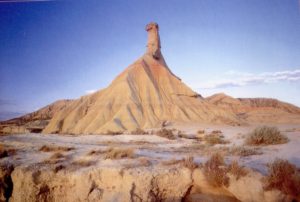
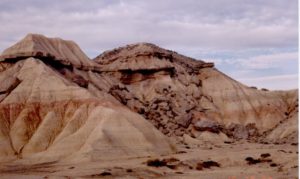
But some better photos here. We found the roads in this area very bad and would not visit again just view from the main road. Carry on the N121 to Olite – There are many more interesting places in this area but you need longer to visit i.e. Sanguesa – Carcastillo – Monasterio Los Olives – Pitilles and Ujue
Olite is a fabulous medieval town which is dwarfed by its bewitching lofty towered Palacio Real de Olite built for the King of Navarra in 1407.
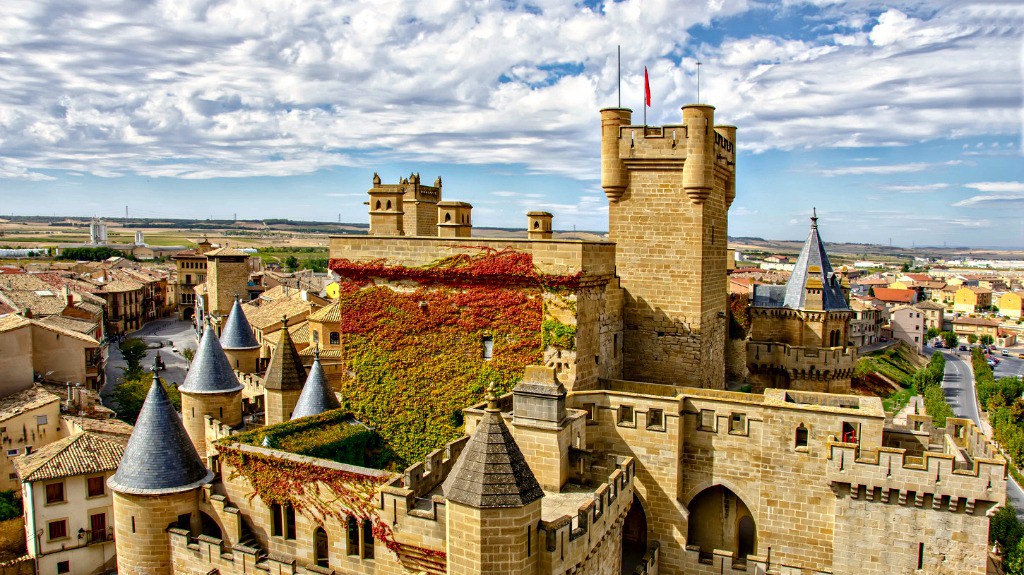
Palacio Real de Olite
In the file is a town map. Tafalla & Olite are known as the flowers of Navarra.
On 6th November we stayed at Hotel de Merindad in Olite and have the bill in the file.
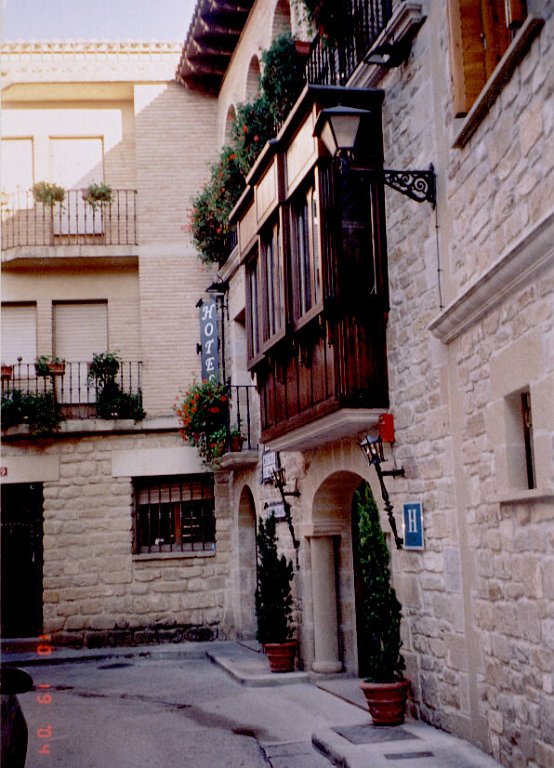
Sunday 7th November
By this time we had travelled 782 km and we left Olite at just after 10.00 and drove to Tafalla (old Tafalla has an impressive main square), then on the NA132 onto Estella, which was a lovely journey across flat agricultural land with vineyards. Some good photos here
Estella is known for its beauty stop along the pilgrim route. A Miracle here in 1090 – nightly showers of shooting stars always falling in the same place on a hill – they found a cave sheltering a statue of the virgin. The arcaded Plaza de Santiago is overlooked by the Basilica de Nuestra Senora de Put – a must on the pious pilgrim route, visit the San Miguel 12th century parish church set on a craggy rock – or cross the medieval bridge to San Sepolcro.
Many important places to visit including the Monasterio de Irache 2 km west at Ayegui open on Sunday 9 – 2 where there is a most interesting Bodega producing DO Navarra wine. We bought a 1970 Gran Reserve (28 euros)

Monasterio de Irache
We have a map of Estella in the file and here is a video
On to Lodosa on a lovely straight road across beautiful arable countryside arriving at an interesting town with dried peppers – garlic and fruit hanging from windows. Left town over the lovely old bridge then left onto NA123 then leave the province of Navarra and enter La Rioja to Calahorra – information on this town is in the file, Despite its down-at-heel appearance it has an interesting history.
Then the LR134 to Arnedo which is a shoemaking town with a Museo de Calzado and Arnedillo – La Riojas most important spa since 1847 with hot salty water good for rheumatic arthritis and stress. This area was full of tourists from Madrid so no place to park – must visit again some time.
Moved on to see the largest concentration of dinosaur tracks and the best places to find them are in Prejano east of Arnedillo

Could not find the Dinosaurs but did find a superb restaurant just as we entered the town!! La Posada del Laurel in Prejano
Back to Arnedo then LR123 to El Villar de Arnedo N232 toward Logrono then Najera. The Santa Maria Real was closed due to renovation This is bustling furniture making town with an illustrious pedigree. After the Moors flattened Pamplona in 918 the kings of Navarra chose to live in Najera – mainly to keep an eye on the ambitious upstart kingdom of Castile P133 NS
Then onto Santa Domingo de Calzada and the Parador were booked for Sunday & Monday at a special price of 75.34 euros per night including breakfast. See info in a file. Some photos
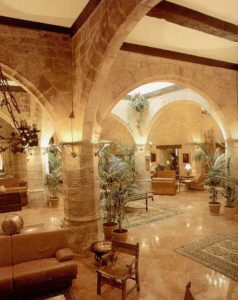
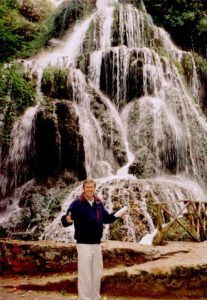
Monday 8th November
We left at 9.30 with a mileage of 1.058 km
After a good breakfast straight road of 15 km to Haro to visit the wine areas and bodegas. Haro is a working wine town built around a large arcaded square. Walked round the town and visited Info Centre – map in file.
11.00 a.m. we visited Compania Vinícola del Norte de Espana This is in the Railway station quarter. It was founded in 1879. This is known by the initials CVNE and pronounced Coo-nay. Under the Cune lable there is a reliable red crianza Cune Rioja Clarette. We bought 12 bottles of Imperial Grand Reserve for 254 euros
From Haro took the A68 to Cenicero – then LR113 back to Najera – continued through Najera on LR1143 to Banos de Rio and continued on to Bobadilla into the mountains to Anguiana and on to visit the Monasterio de Valvanera
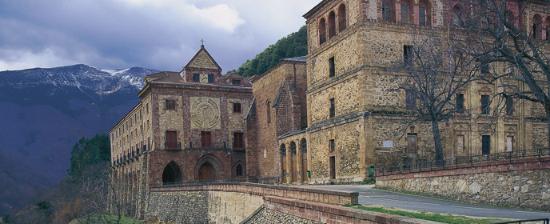
Here are our photos
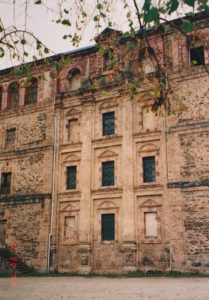


From here returned to Najera (30 km) then Cenicero opposite is Elciego – (Rioja Alavesa) a hill village in the Basque country facing Cenicero across the River Ebro. It is home of the Bodegas Margues de Riscal founded in 1860 And Bodegas Valdelana established 17 years later. The town is noted for its steep, narrow streets and noble houses, complete with ancient crests and a church with wonderful views of the local vineyards
From here to La Guardia – a very quick visit and into Logrono. Half of all the 250,000 Riojans live in Logroño – a shiny, up-to-date capital famous not only for wine but also for coffee caramels which we bought. Unfortunately again Cathedral closed due to renovations. Back on N120 to Santo Domingo and visited the cathedral.
Tuesday 9th November
We left at 9.45 and we had now done 1,284 km
Left and headed onto Ciruena (see new Golf course!) – Villar de Torre – Berceo and San Millan de la Cogolla (see brochures) and photo below From Najera it is a 17 km detour south into the Sierra de la Demanda and this village Grez up around two ancient monasteries. YUSO is the lower and SUSO the upper. (Do not go up to Suso without a ticket) Joined a Spanish tour around Yuso (brochure in the file) After leaving the Monastery leave 205 Back to Badaran, Cardenas, Tricio and then Navarrete – which makes ceramics and rose wine
From Najera it is a 17 km detour south into the Sierra de la Demanda and this village Grez up around two ancient monasteries. YUSO is the lower and SUSO the upper. (Do not go up to Suso without a ticket) Joined a Spanish tour around Yuso (brochure in the file) After leaving the Monastery leave 205 Back to Badaran, Cardenas, Tricio and then Navarrete – which makes ceramics and rose wine
Then to Entrena then LR137 until N111 Istallana . Torcecilla en Cameros has an attractive old centre and another church with frescoes. The 16th century Nuestra Senora de Tomalos. Villoslade de Camareras (where we came off the road and had lunch – Jo had trout which was delicious)

Villoslade de Camareras
Then on to San Andres, Almarza, Soria, Catalud and from here at least 28 km of lovely road through hills and valleys and take the 231 to Nuevazos and Monasterio de Piedra where we had booked to stay on Tuesday 9th at Monasterio de Pedra
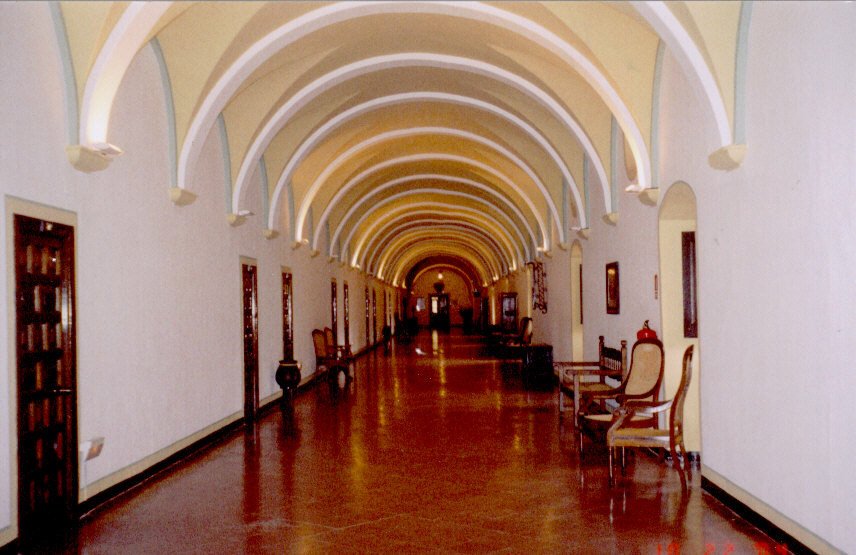
Information, a brochure and a bill for our stay are in the file
Also in the file are a map of Rioja, bodegas of Rioja, some actual bodega brochures and a brochure of the monasteries of Rioja. We did some visits and wine tasting and here is Tony tasting from the wall at Bodegas Irache

Wednesday 10th November
We visited the park and grounds absolutely beautiful with cascading water and autumn leaves and left hotel just before 11.00 having done 1,570 kms.
Took the road to Milmarcos and then Cillas – 44 km of beautiful scenery high up with lots of cultivation. Not a soul on the road except tractors – horsemen and sheep. Nearer to Molina was top of the world a flat straight road with large storage of wheat – then dropping down a little only saw two villages on this road.– then came to Molina de Aragon a walled castle on the hill where we turned left to Monreal de Camp (saffron growing area with Saffron Museum
Then Teruel (Pop 35,000) some 145 km from Valencia. Almost 1,000 m up on the Meseta famed for its Mudejar brick architecture (for which it has been named the Pink City, its cured hams (jamon serrano) and its ill-fated legendary lovers – the Spanish equivalent of Romeo & Juliet.
The immediate surrounding landscape is dry and ochre-coloured but the province of Teruel has some attractive mountains, including the Montes Universales around Albarracin, the Maestrazgo and the sierras around Rubielos de Mora. Teruel was the site of an important battle of the civil war during which freezing winter temperatures contributed to heavy casualties on both sides
Don’t miss the Lovers Mausoleum beside the church of San Pedro. (temporarily moved to the church) Two mummified bodies found in 1555 assumed to be those of the famous Lovers Of Teruel, lie on display below marble statues – the hands of which reach out for each other but do not quite meet. The story goes Isabel de Segura a beautiful girl from a wealthy family, falls in love with Diego de Marcilla, a young man from humble origins and a second son to boot i.e. he doesn’t stand to inherit. Isabel’s father opposes the marriage but Diego begs for five years to make his fortune. In the meantime, Isabel is betrothed to another. Diego, rich but mortally wounded in battle, arrives back in Teruel as Isabel’s wedding bells ring out. That night he steals into the house in which the newlyweds are asleep, wakes Isabel and asks her for the last kiss. She refuses him and he collapses and dies. The next day, as the mourners gather around Diego’s bier, Isabel flings herself on Diego’s body and dies of despair. Bought ham & peaches and had lunch
Video of Teruel
Leaving the city we took the N234 back to Valencia which was busy with lorries so at Segorbe headed across the route to Lliria then on the C234 back toward Valencia – then joined the motorway back to Javea
The total journey was 2,002 km and we arrived home at 6.00 pm